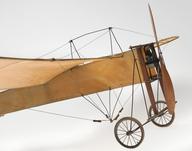Driving mechanism for Frost's experimental Ornithopter
Driving mechanism for Frost's experimental Ornithopter
The flapping mechanism consists of a 31/2 hp (2.61 kw) single-cylinder Antoine motorcycle engine driving a chain reduction gear and crank The wings beat at 100 strokes a minute. On test, suspended by a rope from a tree, the whole machine was said to rise about two feet at each stroke looking ‘just like a gigantic bird trying to fly' and a spring balance showed a lift of 80-160 lbs (36-72 kg) on the downstroke. However, it weighed 232 lb (105 kg) so clearly could not have flown.
- Object Number:
- 1925-407 Pt1
- type:
- driving mechanism






